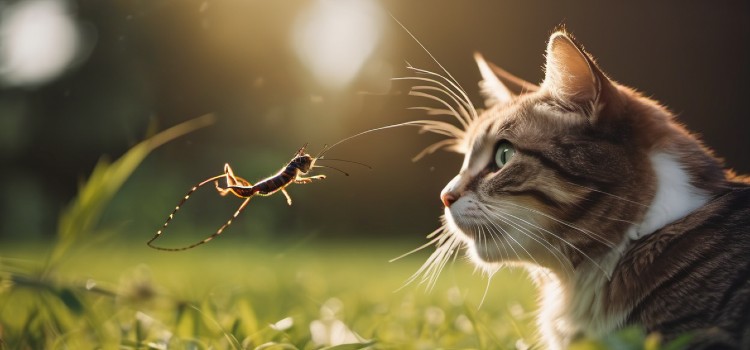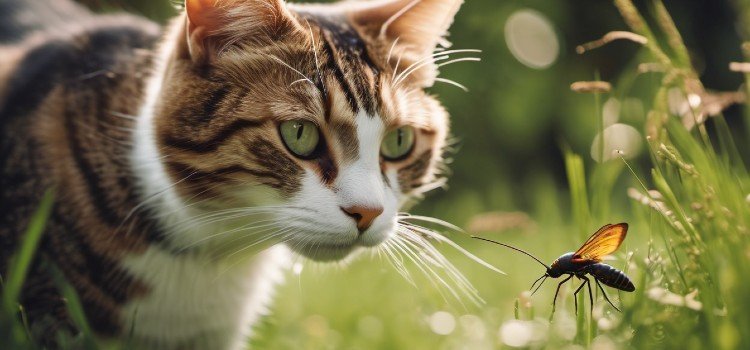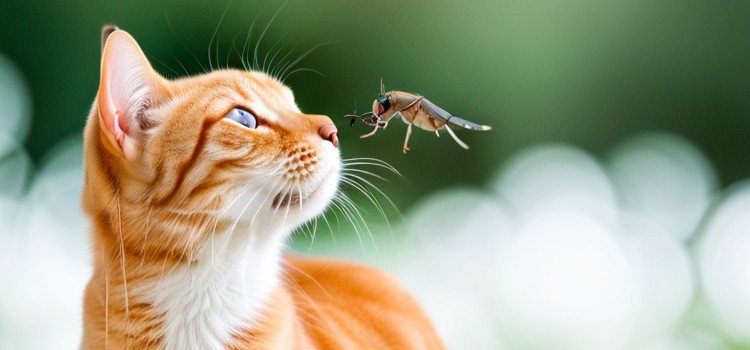As an Amazon Associate committed to the mission of improving the lives of our readers, Live-Clear.com receives a small commission from eligible purchases made through our affiliate links. This revenue enables us to keep producing insightful articles and other material.
Earwigs are not typically dangerous to cats, but can cause minor irritation if bitten. However, it is important to keep cats from eating earwigs, as larger quantities can lead to an upset stomach or gastrointestinal issues.
So, it’s best to take precautions to prevent cats from interacting with earwigs. Earwigs are a common insect that can be found in gardens, homes, and yards. Known for their unique pincer-like appendages at the end of their abdomen, these creatures have often sparked curiosity and concern, especially for pet owners.

If you’re a cat owner, you may be wondering whether earwigs pose any danger to your feline friend. Though earwigs are generally harmless to cats, it’s important to be aware of their potential effects if your cat encounters them. We will examine whether earwigs are dangerous to cats and the precautions you can take to ensure your cat’s safety. Stay tuned to understand the relationship between earwigs and your furry companion and learn how to mitigate any risks that may arise.
Earwig Behavior And Anatomy
Earwigs have peculiar behavior and anatomy, but they are not dangerous to cats. These insects possess pincers at the rear, but they rarely use them for defense, making them harmless to felines.
Earwigs are fascinating creatures that often spark a mix of curiosity and concern. Understanding their behavior and anatomy is crucial when it comes to determining whether they pose any danger to our feline friends. In this section, we will explore the physical characteristics of earwigs, their habitat and behavior, as well as whether or not they can bite or sting.
Physical Characteristics Of Earwigs
Earwigs, scientifically known as Dermaptera, are insects with distinct physical characteristics. Here are some key features that define their appearance:
| Physical feature | Description |
| Length | Varies from 0.2 to 2 inches (5 to 50 millimeters) long. |
| Body structure | Long and slender with a pair of pincers, or forceps, at the rear. |
| Color | Typically brown or black, but some species may have reddish or yellowish hues. |
| Wings | Most earwigs have wings, but they rarely fly and prefer to crawl. |
Habitat And Behavior Of Earwigs
Earwigs are commonly found in damp and dark environments, such as under logs, in mulch, or among garden debris. They are nocturnal creatures, meaning they are primarily active during the night. However, you may occasionally spot them during the day seeking shelter in cool, shaded areas. These insects are omnivorous, meaning they consume both plant matter and small invertebrates. They play a beneficial role in gardening by feeding on aphids, mites, and other pests. Although their reputation may lead some to believe they are dangerous, earwigs are generally harmless and prefer to avoid human and animal contact.
Do Earwigs Bite Or Sting?
The question of whether earwigs pose a threat to cats often stems from concern about their pincers or forceps. However, it is important to note that these pincers are primarily used for defense and mating purposes, rather than offensive attacks. Earwigs do have the ability to pinch, but their forceps are not known to cause significant harm to cats. Additionally, earwigs are not known to possess venom or stingers. While they may exhibit defensive behavior if they feel threatened, such as releasing a foul-smelling liquid or pinching with their forceps, these reactions are typically more of a startle tactic.
In conclusion, earwigs may startle your cat with their unique appearance, but they are generally harmless creatures. Understanding their behavior and anatomy can help alleviate concerns and provide reassurance that earwigs do not pose a significant danger to our feline companions.
Earwigs And Cats
Earwigs do not pose significant dangers to cats. While they may pinch if threatened, earwigs are unlikely to cause harm to your feline friend.
How Do Cats Interact With Earwigs?
Cats are naturally curious creatures, and it is not uncommon to find them chasing after bugs or insects. Earwigs, with their unique appearance, may pique a cat’s interest. However, it is important to understand how cats interact with earwigs to ensure the safety of our feline friends. When a cat comes across an earwig, it may bat at it with its paws or try to play with it.
Cats have sharp claws and teeth, which they may use to catch and hold onto the earwig. This interaction can be both fascinating and entertaining to watch, as the cat uses its hunting instincts to capture the insect.
Are Earwigs A Threat To Cats?
Despite their seemingly intimidating pincers, earwigs are generally not a threat to cats. The pincers they have at the end of their abdomen are primarily used for defense against predators or fighting for territory amongst themselves. While earwigs may use their pincers in self-defense, they are not harmful enough to cause any serious injuries to a cat. It is important to note that some cats may have allergic reactions to insect bites or stings, including those from earwigs. In such cases, it is best to monitor your cat for any signs of discomfort or allergic reactions.
If you notice any unusual symptoms, such as excessive swelling, redness, or difficulty breathing, it is advisable to seek veterinary care.
Can Cats Eat And Digest Earwigs Safely?
Cats have a natural instinct to hunt and eat small creatures, including insects. While some bugs can be harmful to cats when ingested, earwigs are generally considered safe for consumption. Earwigs do produce a foul-smelling liquid as a defense mechanism, which may deter cats from eating them. However, it is important to keep in mind that some cats may have individual sensitivities or allergies to certain foods or insects. If you notice any adverse reactions after your cat has consumed an earwig, such as vomiting, diarrhea, or lethargy, it is recommended to consult with your veterinarian for further guidance.
In conclusion, earwigs are not typically a threat to cats. With their natural hunting instincts, cats may playfully interact with earwigs, but serious injuries are unlikely. While cats can consume earwigs without major concerns, it is important to monitor for any signs of allergic reactions or individual sensitivities.

Potential Risks For Earwigs Dangerous to Cats
While earwigs may not be commonly associated with danger, it is important for cat owners to be aware of the potential risks these insects can pose to their feline companions. Cats are curious creatures and may come into contact with earwigs during their outdoor adventures. In this section, we will explore the possible dangers of earwigs to cats, including allergic reactions, ingestion of harmful substances, and the complications that can arise from earwig bites.
Allergic Reactions In Cats
Cats, just like humans, can experience allergic reactions to various allergens, including insects. While earwig allergies in cats are relatively rare, they can still occur. When a cat comes into contact with an earwig, it may develop symptoms such as skin irritation, redness, swelling, itching, and even respiratory issues. It is important to monitor your cat for any signs of an allergic reaction and seek veterinary care if necessary.
Ingestion Of Harmful Substances From Earwigs Dangerous to Cats
Cats are notorious for their grooming behaviors, and they may occasionally ingest insects while cleaning themselves. If a cat ingests an earwig, it is possible for the insect to release harmful substances. While it is unlikely to cause severe toxicity, ingestion of certain compounds found in an earwig’s body, such as formic acid, can lead to gastrointestinal upset in cats. If you suspect that your cat has ingested an earwig or is experiencing digestive issues, consult with your veterinarian for guidance.
Possible Complications From Earwigs Dangerous to Cats
Earwigs have a pair of pincers at the rear of their abdomen, which they use for defense. Although earwigs are not aggressive towards humans or animals, if a cat inadvertently provokes an earwig and gets bitten, complications can arise. Earwig bites on cats can result in localized skin irritation, redness, and potential secondary infections if the affected area is scratched excessively. Promptly clean and disinfect any bite wounds on your cat and keep a close eye on the area to ensure proper healing.
Preventing Earwig-related Issues
When it comes to the safety of our furry friends, it is important to be aware of potential threats like earwigs. These small insects, with their pincer-like appendages, are often found in damp and dark places, such as gardens and basements. While they may not be directly harmful to cats, they can still cause some issues. Thankfully, there are preventive measures you can take to minimize the risk and keep your feline companion safe. Let’s explore some effective ways to prevent earwig-related issues.
Maintaining A Clean And Hygienic Environment For Earwigs Dangerous to Cats
A clean and hygienic environment is essential for the overall well-being of your cat. This also helps to prevent earwig infestation. Regularly clean your cat’s bedding, litter box, and litter tray. Dispose of waste appropriately and use cat-safe disinfectants when cleaning their belongings. By keeping the living area tidy and free from debris, you can create a less favorable environment for earwigs to thrive.
Avoiding Areas Where Earwigs Dangerous to Cats
Earwigs typically prefer dark, moist areas, so it’s important to identify and avoid such places to reduce the risk of encounters. Seal any cracks or crevices in your home where these pests can enter. Also, make sure to keep the basement, garage, and garden free from clutter and excess moisture. By eliminating potential hiding spots and minimizing their ideal habitats, you can help protect your cat from contact with earwigs.
Regular Grooming And Preventive Measures For Earwigs Dangerous to Cats
To further safeguard your cat from earwig-related issues, regular grooming and preventive measures are crucial. Regularly inspect your cat’s ears for any signs of infestation or irritation. If you notice anything unusual, consult with your veterinarian for appropriate treatment. Additionally, using cat-friendly pest control methods can help prevent earwig encounters. Talk to your vet about the best options for your furry friend.
In conclusion, while earwigs may not pose a direct threat to cats, it’s important to take preventive measures to minimize the risk of any issues. Maintaining a clean and hygienic environment, avoiding areas where earwigs thrive, and implementing regular grooming and preventive measures for cats are effective strategies to keep them safe. By staying proactive and aware, you can ensure a happy and earwig-free environment for your beloved feline companion.

What To Do If A Cat Encounters An Earwig
Earwigs are small insects that are not typically a threat to cats. However, if a cat encounters an earwig, it’s important to closely monitor them for any potential symptoms. While earwigs themselves are not dangerous to cats, they can cause irritation or discomfort if they come into contact with sensitive areas such as the ears, nose, or mouth. This article will guide you on what to do if your cat encounters an earwig, from observing your cat for symptoms to removing earwigs safely and seeking veterinary assistance if necessary.
Observing Your Cat For Symptoms Of Earwigs Dangerous to Cats
When your cat encounters an earwig, it’s crucial to observe them for any signs of discomfort or irritation. Keep an eye out for the following symptoms:
- Excessive scratching or rubbing: If your cat is scratching or rubbing their ears, face, or body more than usual, it could indicate irritation caused by the earwig.
- Redness or inflammation: Check for any redness or inflammation around the ears, nose, or mouth. This could be a sign of a reaction to the earwig.
- Head shaking or tilting: If your cat is frequently shaking or tilting their head, it could be a response to discomfort or irritation caused by the earwig.
- Discharge or odor: Take note of any unusual discharge or foul odor coming from your cat’s ears. It could indicate an infection caused by the presence of an earwig.
Removing Dangerous Earwigs Safely From Your Cat
If you notice an earwig on your cat or suspect they may have been in contact with one, it’s important to remove it promptly and safely. Follow these steps to remove earwigs from your cat:
- Gently restrain your cat to ensure they stay still during the process. Use a calm and gentle approach to avoid stressing your pet.
- Use tweezers or forceps to carefully grasp the earwig. Be cautious not to squeeze or crush the insect, as it may release irritants.
- Hold the tweezers close to the cat’s skin and slowly pull the earwig out in a steady and controlled manner.
- Inspect the affected area for any signs of injury or irritation. If necessary, clean it gently with a mild antiseptic solution and consult a veterinarian.
Consulting A Veterinarian If Necessary
If you are unsure about how to handle the situation or notice any persistent symptoms in your cat, it’s important to consult a veterinarian. A veterinarian can provide professional advice, perform a thorough examination, and administer appropriate treatment if needed. They may recommend further interventions such as ear cleaning, medication, or preventive measures to avoid future encounters with earwigs.
Remember, while it’s uncommon for earwigs to pose a significant danger to cats, it’s essential to take action and provide proper care for your feline companion if they encounter these insects. By observing your cat, safely removing any earwigs, and seeking veterinary assistance when necessary, you can ensure your cat remains happy and healthy.
Natural Remedies And Deterrents
Earwigs can be a nuisance to cats, but they are not dangerous. Natural remedies and deterrents such as removing their hiding spots and using essential oils can help keep them away from your furry friend.
Safe And Effective Natural Deterrents For Earwigs Dangerous to Cats
If you are looking for safe and effective ways to keep earwigs away from your cat, there are several natural deterrents that you can try. These options are not only pet-friendly but also environmentally friendly, making them a great alternative to chemical solutions. Here are some natural remedies you can use to discourage earwigs from approaching your furry friend:
Herbs And Plants That Repel Earwigs
Certain herbs and plants have properties that repel earwigs. By strategically placing them around your cat’s favorite areas, you can create a barrier that deters these unwanted pests. Some effective options include: –
- Lavender: Not only does lavender smell wonderful to us, but it also repels earwigs. Planting lavender near areas where your cat spends time can help keep earwigs at bay.
- Mint: Mint is another herb that has a strong scent that earwigs dislike. Planting mint around your cat’s outdoor play area can act as a natural deterrent.
- Chrysanthemums: Chrysanthemums contain a natural pesticide called pyrethrum, which can repel earwigs. Planting these flowers in your garden can help create an earwig-free zone for your cat.
Creating A Cat-friendly Earwig-free Zone
In addition to using herbs and plants to repel earwigs, you can also create a cat-friendly earwig-free zone around your home. By taking a few simple steps, you can ensure that your cat’s favorite areas are free from these pesky insects. Here are some tips:
- Remove debris: Earwigs tend to hide in dark and damp places, such as piles of leaves or wood. Regularly cleaning up debris around your home and keeping the area tidy can help reduce their hiding spots.
- Seal entry points: Check your home for any cracks or openings that could serve as entry points for earwigs. Seal these gaps to prevent them from entering and potentially reaching your cat.
- Use natural deterrents: Consider using natural deterrents such as diatomaceous earth or boric acid around your home’s perimeter. These substances are safe for pets but can be effective at repelling earwigs. By implementing these safe and effective natural deterrents, you can help protect your cat from any potential dangers that earwigs might pose.
Remember, always prioritize your pet’s safety and well-being when choosing pest control methods.

Conclusion
Earwigs can be a nuisance for cats, but they are generally not dangerous. While they may use their pincers in self-defense, they rarely pose a serious threat to felines. It is important, however, to be aware of potential allergies or skin irritations that could arise from contact with these insects.
Frequently Asked Questions For Are Earwigs Dangerous To Cats
Earwigs pose minimal threat to cats as they rarely bite and are not venomous.
Earwig bites on cats are typically harmless and may cause minimal pain or irritation.
No, earwigs are not known carriers of diseases that can affect cats.
To protect your cat from earwigs, ensure proper sanitation and remove any potential hiding spots.
If your cat encounters an earwig, there is no need to panic. Simply remove the earwig gently and monitor for any signs of discomfort or allergic reaction.
Overall, keeping your cat’s living environment clean and implementing preventive measures can help ensure their safety and well-being. Stay informed and consult a veterinarian if you have any concerns about earwig encounters with your furry friend.
Amazon and the Amazon logo are trademarks of Amazon.com, Inc, or its affiliates.



